Overclockable Pentium Anniversary Edition Review: The Intel Pentium G3258
by Ian Cutress on July 14, 2014 10:00 AM EST- Posted in
- CPUs
- Intel
- Pentium
- Overclocking
- Pentium-AE
- G3258
CPU Benchmarks
The dynamics of CPU Turbo modes, both Intel and AMD, can cause concern during environments with a variable threaded workload. There is also an added issue of the motherboard remaining consistent, depending on how the motherboard manufacturer wants to add in their own boosting technologies over the ones that Intel would prefer they used. In order to remain consistent, we implement an OS-level unique high performance mode on all the CPUs we test which should override any motherboard manufacturer performance mode.
HandBrake, SD Film: link
For HandBrake, we take two videos (a 2h20 640x266 DVD rip and a 10min double UHD 3840x4320 animation short) and convert them to x264 format in an MP4 container. Results are given in terms of the frames per second processed, and HandBrake uses as many threads as possible.
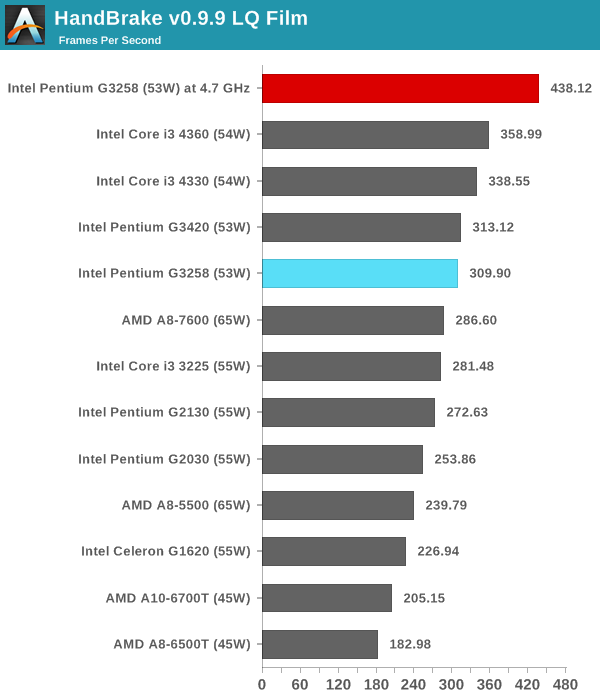
For low quality encoding, single threaded performance wins out over threads despite the extra multi-threading of i3 processors.
HandBrake, 4K60 Animation: link
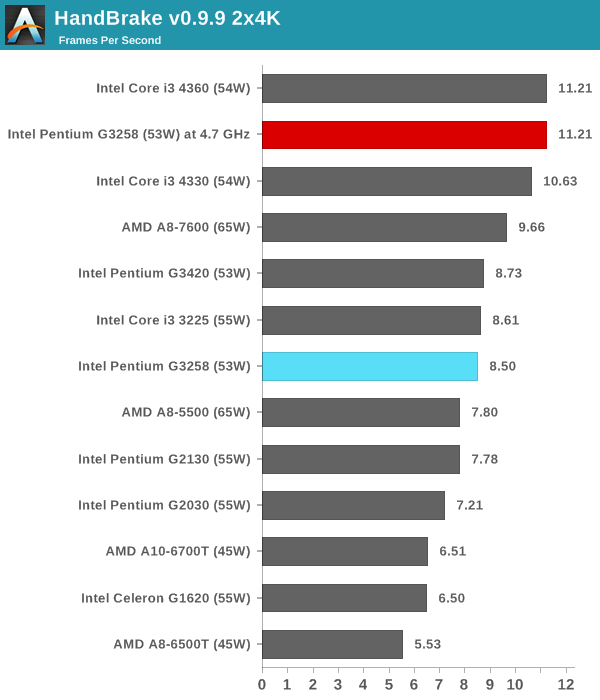
For larger frame sizes, the extra MHz of the overclock brings it on par with the i3-4360, although one might suggest spending the extra $40 for the i3 to ensure full stability.
Agisoft Photoscan – 2D to 3D Image Manipulation: link
Agisoft Photoscan creates 3D models from 2D images, a process which is very computationally expensive. The algorithm is split into four distinct phases, and different phases of the model reconstruction require either fast memory, fast IPC, more cores, or even OpenCL compute devices to hand. Agisoft supplied us with a special version of the software to script the process, where we take 50 images of a stately home and convert it into a medium quality model. This benchmark typically takes around 15-20 minutes on a high end PC on the CPU alone, with GPUs reducing the time.
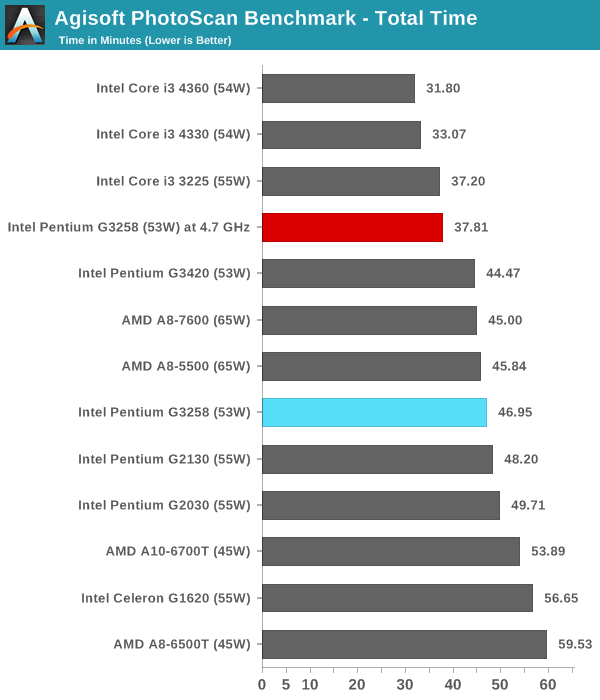
Dolphin Benchmark: link
Many emulators are often bound by single thread CPU performance, and general reports tended to suggest that Haswell provided a significant boost to emulator performance. This benchmark runs a Wii program that raytraces a complex 3D scene inside the Dolphin Wii emulator. Performance on this benchmark is a good proxy of the speed of Dolphin CPU emulation, which is an intensive single core task using most aspects of a CPU. Results are given in minutes, where the Wii itself scores 17.53 minutes.
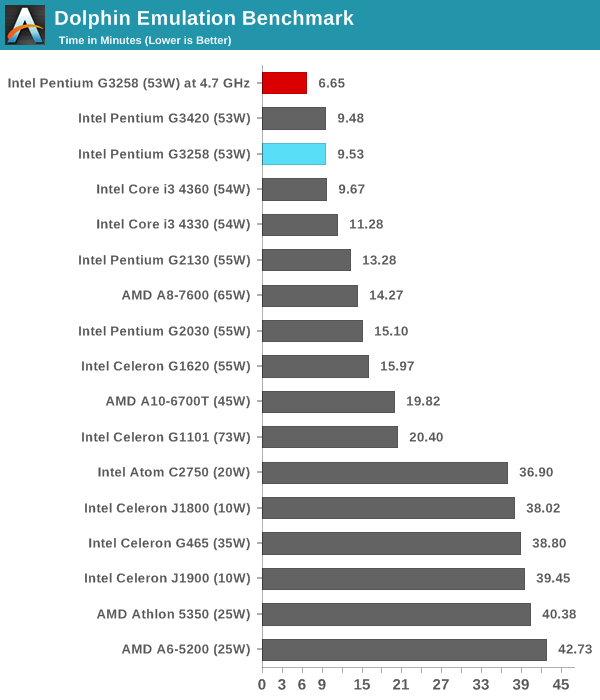
Dolphin is another example where Haswell combined with strong single threaded performance wins.
WinRAR 5.0.1: link
This test compresses a set of 2867 files across 320 folders totaling 1.52 GB in size – 95% of these files are small typical website files, and the rest (90% of the size) are small 30 second 720p videos.
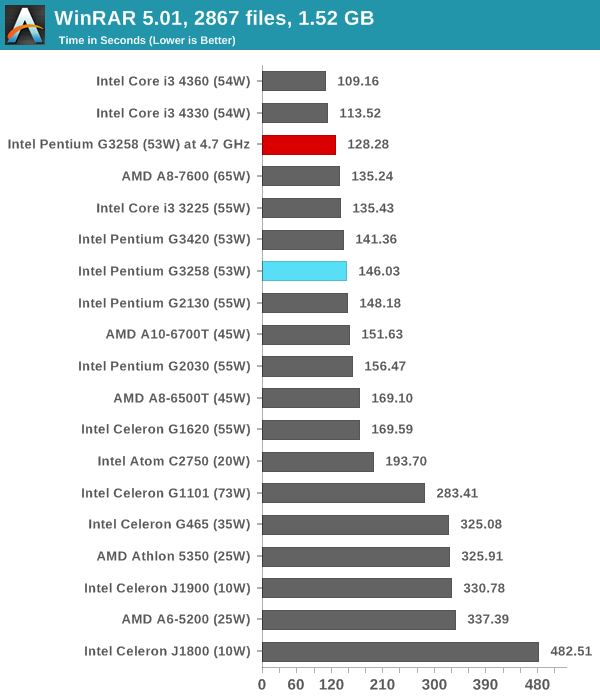
PCMark8 v2 OpenCL on IGP
A new addition to our CPU testing suite is PCMark8 v2, where we test the Work 2.0 and Creative 3.0 suites in OpenCL mode. As this test is new, we have not run it on many AMD systems yet and will do so as soon as we can.
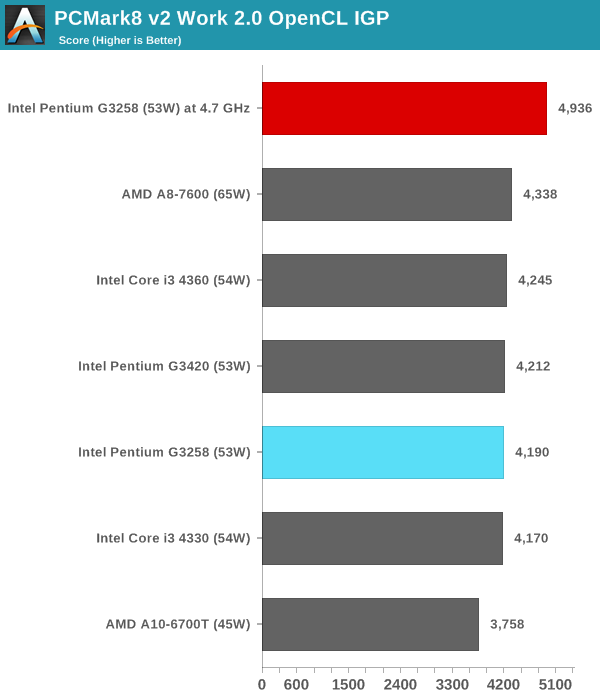
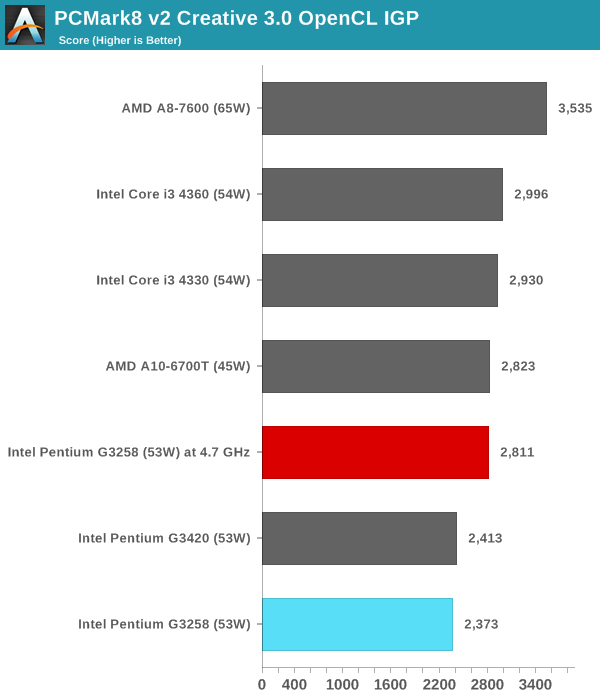
In both of our PCMark8 v2 results, overclocking the CPU gave a significant jump in performance. This would be down to the single threaded nature of parts of the benchmark, allowing web browsing and the snappyness of the system to be sped up.
Hybrid x265
Hybrid is a new benchmark, where we take a 4K 1500 frame video and convert it into an x265 format without audio. Results are given in frames per second.
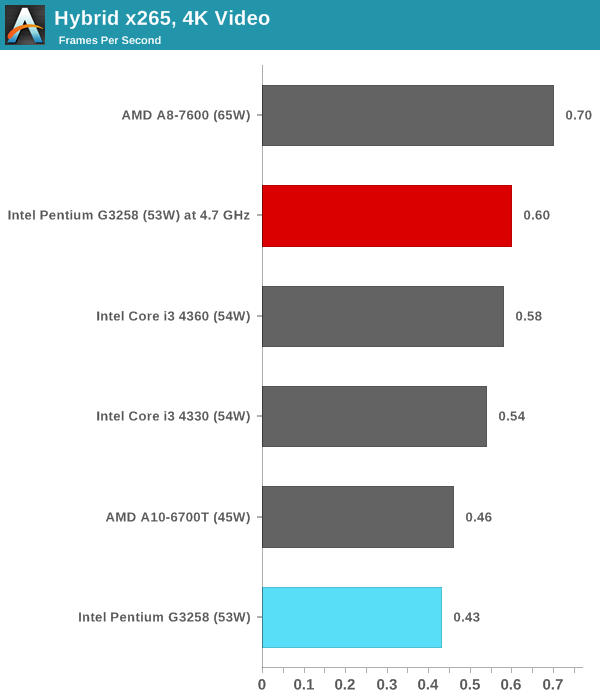
Almost an extra 50% performance for Hybrid x265 encoding.
Cinebench R15
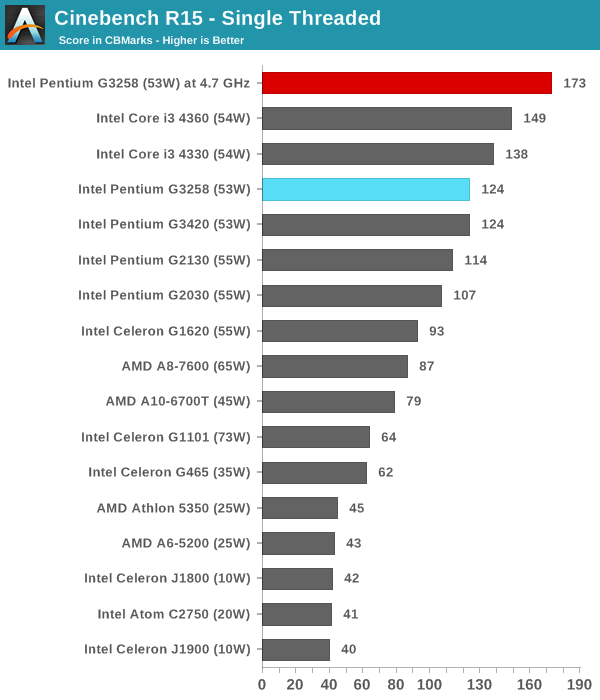
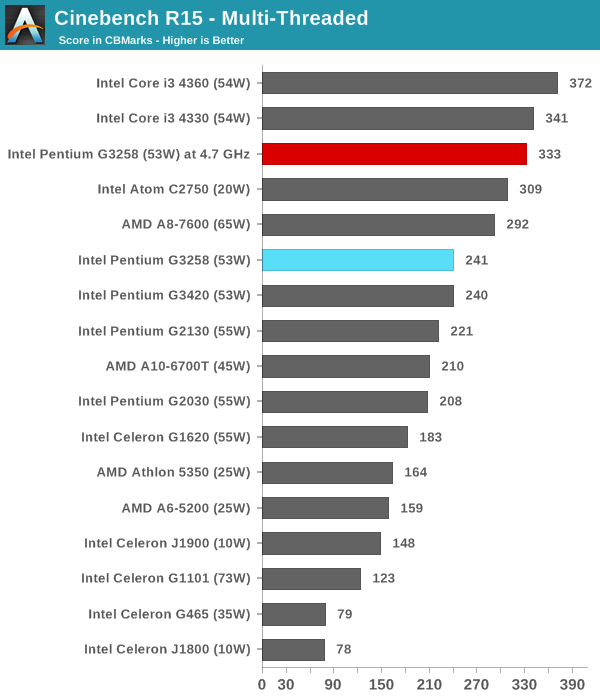
3D Particle Movement
3DPM is a self-penned benchmark, taking basic 3D movement algorithms used in Brownian Motion simulations and testing them for speed. High floating point performance, MHz and IPC wins in the single thread version, whereas the multithread version has to handle the threads and loves more cores.

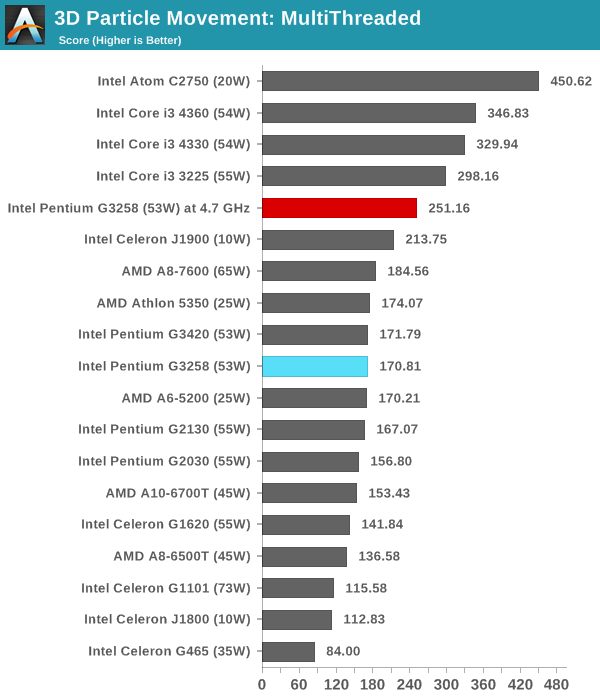
FastStone Image Viewer 4.9
FastStone is the program I use to perform quick or bulk actions on images, such as resizing, adjusting for color and cropping. In our test we take a series of 170 images in various sizes and formats and convert them all into 640x480 .gif files, maintaining the aspect ratio. FastStone does not use multithreading for this test, and results are given in seconds.
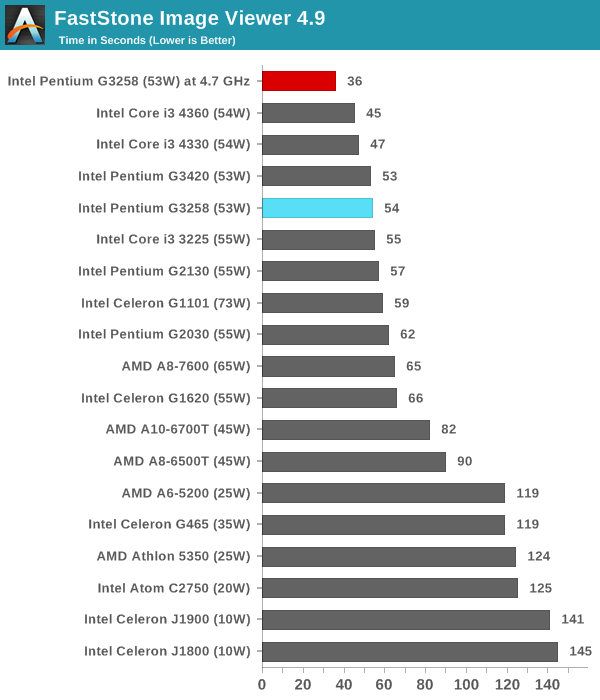
Web Benchmarks
On the lower end processors, general usability is a big factor of experience, especially as we move into the HTML5 era of web browsing. For our web benchmarks, we take four well known tests with Chrome 35 as a consistent browser.
Sunspider 1.0.2
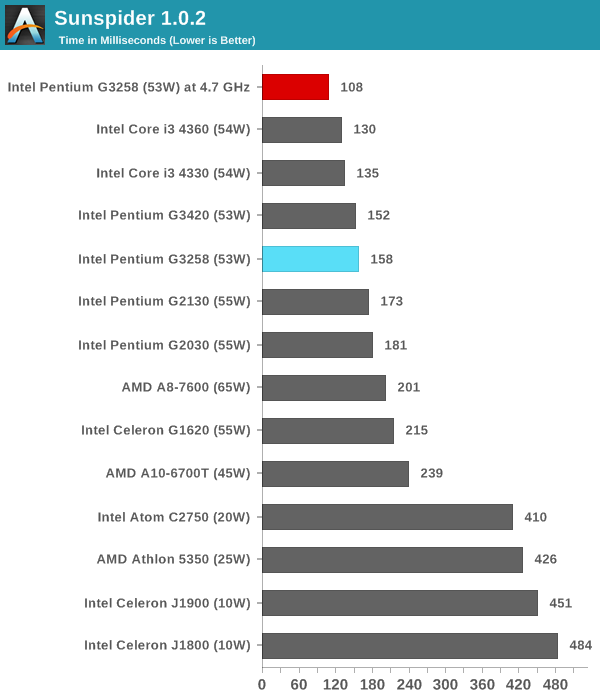
Mozilla Kraken 1.1
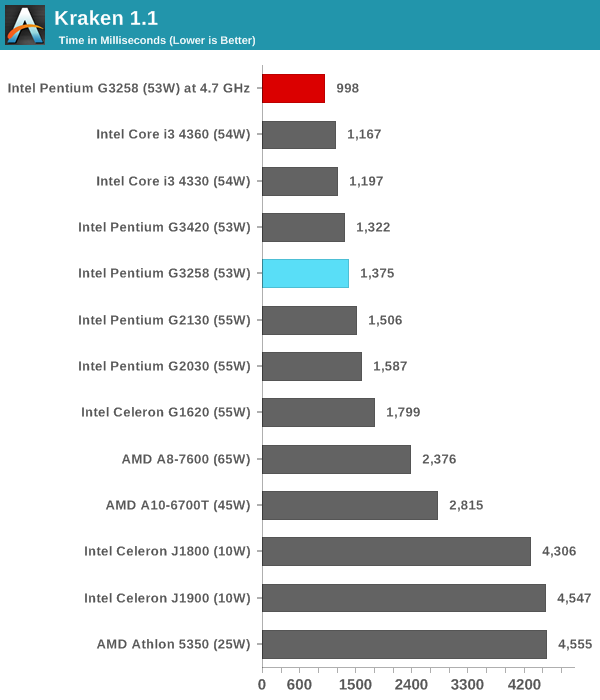
WebXPRT
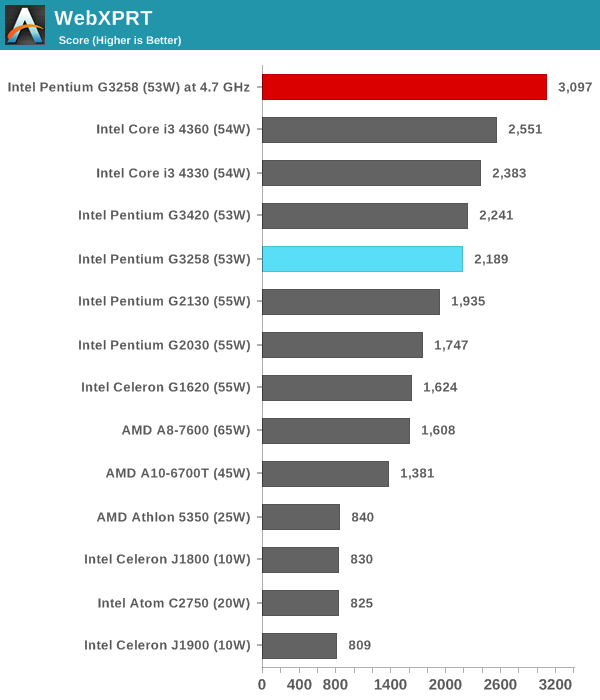
Google Octane v2
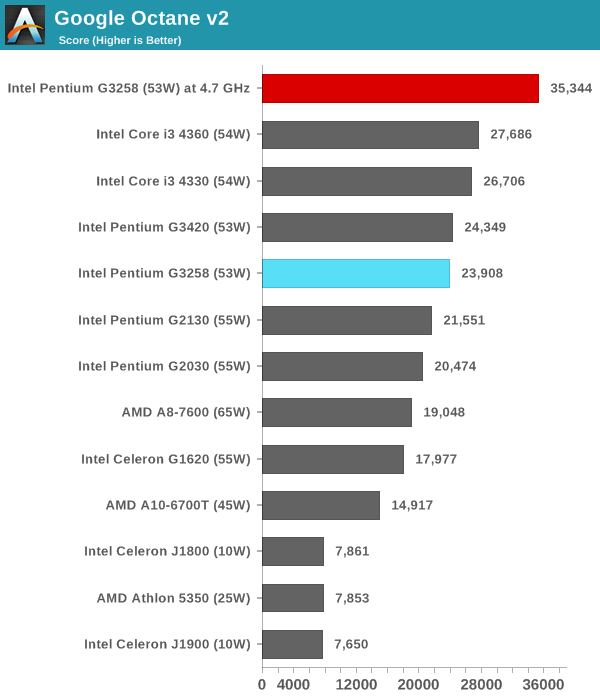
The usage model for an overclocked G3258 comes in highly single threaded environments. 4.7 GHz is nothing to be sniffed at, especially when it comes to web browsing or simple photo editing where it beats out more expensive processors. With multithreaded scenarios, it battles with the i3 depending on if the software can use hyperthreading to its full advantage. If the software can do that, then the i3 still wins out.










96 Comments
View All Comments
extide - Tuesday, July 15, 2014 - link
EDIT: I am talking about stock speeds, of course.plonk420 - Monday, July 14, 2014 - link
could you guys do some more games (and try the Celeron G1820 or G1840--the cheapest Haswell Intels on The Egg)? don't have a lot of cash at the moment and am curious about the cheapest of cheap livingroom gaming boxes i could build...Marburg U - Monday, July 14, 2014 - link
Ian, there is no such thing as "free performance" when the cpu is designed and sold as an overclockable cpu.MikeMurphy - Monday, July 14, 2014 - link
It's free given there is no price premium with this particular chip.ervinshiznit - Monday, July 14, 2014 - link
Ian, you are mistaken. The core i5 and i7 K editions have AVX and AES support. Look it up on Intel's ARK processor feature filter. They do not have TSX support, in contrast to their non K counterparts.Ian Cutress - Monday, July 14, 2014 - link
That's what I meant :) Having the new DC CPUs support VT-d and TSX and writing about those in the last week had my mind at a slant.kaelynthedove78 - Monday, July 14, 2014 - link
Warning: rant ahead.It is 2014Q3 and still, no reason to upgrade from Sandy Bidge 2600K @ 4.8Ghz, $30 air tower cooler setup to anything Intel has to offer. Load temperature is <80C after 24 hours of non-stop Linpack.
I feel so sad, Ivy Bridge was a downgrade for me, Haswell was an even hotter downgrade and now Devil's Canyon can't reach 4.8GHz even with water cooling. $500 for same performance but hotter than ever? How do these products get raving reviews?!
I need single-thread performance so more slow cores won't help me. Three and half years waiting and still nothing. AMD, VIA, anybody, please come and kick Intel in the behind so I could finally get >10% performance increase after four generations!
DanNeely - Monday, July 14, 2014 - link
Unless we find a successor material for Silicon, at this point I don't think it's going to happen. We appear to've hit an effective clock speed wall; and making the cores/caches themselves bigger is deep into diminishing returns.Casecutter - Monday, July 14, 2014 - link
Thanks for this. I came away with the same deduction after reading other various articles, but those weren't as clear-cut or upfront with the findings. While nice price to start for a CPU, I think after investing in an acceptable OC'n mobo and good cooler, why? An i3 with any regular mobo and stock cooler offers better gaming, and if that's what it about Pentium AE isn't the best route. For the average entry level builds, it best to not give a kid or novice the impression that hitting 4.7Ghz isn’t for the faint of heart.I would’ve like to have seen and FX-6300 as that has been my go-to chip for budget Gaming builds, at $100 along with ASRock 970 Extreme3 R2.0 bundled for around $160 from MicroCenter you can’t bet against it. With most any $20-30 aftermarket cooler, I’ll get a 4.5-4.7Ghz and call it good. For Gaming most every title plays better verses the i3 (say perhaps Arkham City or Shogun 2), while heading into i5 territory.
Ian Cutress - Monday, July 14, 2014 - link
I'm retesting some AM3 CPUs right now and have an FX-6350 being tested at this very moment. Check anandtech.com/bench in the next few days and I'll upload my results.